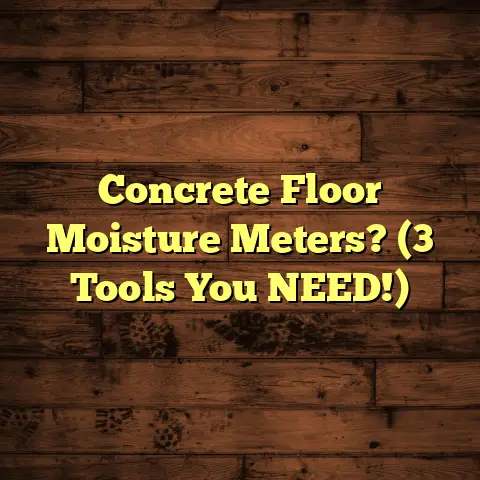Rug Pad on Wood: Which Side? (8 Install Tips!)
I’m a flooring contractor, and I’ve spent years transforming houses into homes, one floor at a time.
And let me tell you, the secret to a truly comfortable and stylish space isn’t just about the hardwood or the area rug itself.
It’s about the often-overlooked hero beneath: the rug pad.
Introduction: The Importance of Comfort in Home Design
Think about it: your floors are the foundation of your
entire living space.
They’re what you walk on,
what you see, and what sets the tone for the room.
The right flooring choices can elevate a space, making it feel warmer, more inviting, and, of course, more comfortable.
That’s where area rugs come in.
They add a touch of personality, define zones within a room, and provide a soft, cozy feel underfoot.
But let’s be honest, a rug alone isn’t enough.
That’s where the unsung hero, the rug pad, steps in.
A good rug pad isn’t just about adding a bit of
cushion.
It’s about so much more.
It provides insulation, dampens sound, and most importantly, protects your beautiful wood floors from scratches, dents, and wear and tear.
And believe me, as someone who’s seen their fair share of damaged wood floors, a rug pad is an investment that pays off in the long run.
Section 1: Understanding Rug Pads
So, what exactly is a rug pad?
Simply put, it’s a layer of material placed between your area rug and your floor.
Its primary function is to provide cushioning, prevent the rug from slipping, and protect both the rug and the floor from damage.
But rug pads aren’t one-size-fits-all.
They come in a variety of materials, each with its own unique benefits.
Let’s take a look at some of the most common types:
Felt: These pads are typically made from recycled fibers and offer excellent cushioning and insulation.
They’re a great choice for adding extra comfort underfoot.-
Rubber: Rubber rug pads are known for their superior grip, preventing rugs from slipping and sliding, especially on smooth surfaces like hardwood.
Memory Foam: If you’re looking for maximum comfort, memory foam is the way to go.
These pads conform to the shape of your feet, providing unparalleled cushioning.-
Felt-Rubber Combo: These pads combine the benefits of both felt and rubber, offering a balance of cushioning and grip.
Now, when it comes to wood floors, choosing the right type of rug pad is crucial.
You want a pad that will protect the finish of your floors while still providing the necessary grip and cushioning.
I generally recommend felt-rubber combo pads or natural rubber pads for wood floors.
These materials are gentle on the finish and won’t cause any discoloration or damage over time.
Section 2: The Dilemma: Which Side of the Rug Pad Goes Up?
Okay, now for the question that’s probably on your mind: “Which side of the rug pad goes up?”
It’s a valid question, and one that I get asked all the time.
The reasoning behind the question is simple: the way you place the rug pad can affect the rug’s performance and longevity.
Think about it: the rug pad is the interface between your rug and your floor.
If it’s not positioned correctly, it can lead to slipping, bunching, and even damage to your wood floors.
Most rug pads are designed with different textures on each side.
One side is typically smoother, while the other has a more textured or patterned surface.
This difference in texture is intentional and serves a specific purpose.
The textured side is usually designed to grip the rug, while the smoother side is designed to protect the floor.
But here’s the thing: not all rug pads are created equal.
Some may have different designations for the top and bottom, so it’s important to pay attention to the manufacturer’s instructions.
Section 3: Key Considerations for Rug Pad Placement
Let’s dive a bit deeper into the two sides of the rug pad.
On one hand, you have the textured side, which is designed to grip the rug and prevent it from slipping.
This side often features a waffle pattern, a ribbed surface, or some other type of texture that creates friction.
On the other hand, you have the smooth side, which is intended to protect your wood floors.
This side is typically made of a non-abrasive material that won’t scratch or damage the finish.
So, how does the side that faces up affect grip, comfort, and the overall experience of walking on the rug?
Well, if you place the smooth side up, you’re essentially reducing the amount of friction between the rug and the pad.
This can lead to the rug slipping and sliding, which can be both annoying and dangerous.
On the other hand, if you place the textured side up, you’re maximizing the grip and preventing the rug from moving around.
This not only makes the rug more comfortable to walk on but also helps to extend its lifespan by preventing it from bunching up and wearing unevenly.
Now, as I mentioned earlier, different types of rug pads may have different sides designated for the top and bottom.
For example, some felt-rubber combo pads have a felt side that’s designed to face up and a rubber side that’s designed to face down.
In these cases, it’s essential to follow the manufacturer’s instructions to ensure that you’re installing the pad correctly.
If you’re unsure which side should face up, take a close look at the pad.
The side that’s designed to grip the rug will typically have a more pronounced texture or pattern.
You can also consult the manufacturer’s website or contact their customer service department for clarification.
Section 4: 8 Installation Tips for Rug Pads on Wood Floors
Alright, now that we’ve covered the basics of rug pads and their placement, let’s get into the nitty-gritty of installation.
Here are 8 tips to help you install your rug pad like a pro:
1. Tip 1: Measure Accurately
Before you even think about laying down your rug pad, it’s crucial to measure both the rug and the pad.
You want to make sure that the pad is slightly smaller than the rug, typically by about 1-2 inches on each side.
This will prevent the pad from peeking out from under the rug and creating an unsightly appearance.
To measure accurately, use a measuring tape and record the dimensions of both the rug and the pad.
If the pad is too large, you can trim it down using a pair of scissors or a utility knife.
2. Tip 2: Clean the Wood Floor
Before you lay down the rug pad, take the time to thoroughly clean your wood floor.
This will remove any dirt, dust, or debris that could interfere with the pad’s adhesion.
I recommend sweeping or vacuuming the floor first, followed by a damp mopping with a wood floor cleaner.
Make sure the floor is completely dry before you proceed to the next step.
3. Tip 3: Choose the Right Rug Pad Thickness
The thickness of your rug pad can have a significant impact on both comfort and stability.
A thicker pad will provide more cushioning, but it can also raise the rug too high, creating a tripping hazard.
A thinner pad will be less noticeable, but it may not provide enough cushioning or protection.
As a general rule, I recommend a rug pad that’s between 1/4 and 1/2 inch thick for most rugs.
However, if you have a particularly thick or plush rug, you may want to opt for a thinner pad to avoid creating a tripping hazard.
Here’s a quick guide to help you choose the right thickness:
4. Tip 4: Lay the Pad with the Correct Side Up
This is where things get a little tricky.
As we discussed earlier, it’s crucial to lay the rug pad with the correct side up.
In most cases, the textured side should face up, while the smooth side should face down.
However, it’s always a good idea to double-check the manufacturer’s instructions to be sure.
If you’re unsure which side is which, look for a label or marking on the pad.
You can also try rubbing your hand over each side to feel the difference in texture.
5. Tip 5: Align the Rug and Pad Properly
Once you’ve laid down the rug pad, it’s time to align the rug.
Carefully position the rug over the pad, making sure that it’s centered and straight.
You want to leave a small border of the rug pad visible around the edges of the rug.
This will help to prevent the rug from shifting and sliding.
6. Tip 6: Test for Movement
After you’ve aligned the rug and pad, take a few steps back and admire your work.
Does everything look centered and straight?
If so, it’s time to test for movement.
Walk on the rug and see if it shifts or slides.
If it does, you may need to adjust the position of the pad or add some rug tape to the edges.
7. Tip 7: Regular Maintenance
Once you’ve installed your rug pad, it’s important to maintain it properly.
This includes vacuuming the rug regularly to remove dirt and debris.
You should also rotate the rug periodically to prevent uneven wear.
And every few months, it’s a good idea to lift up the rug and vacuum the floor underneath.
This will help to prevent the buildup of dust and allergens.
8. Tip 8: Seasonal Considerations
Finally, keep in mind that humidity and temperature changes can affect both wood floors and rug pads.
In humid environments, wood floors can expand, while rug pads can become damp and mildewy.
In dry environments, wood floors can contract, while rug pads can become brittle and cracked.
To mitigate these effects, try to maintain a consistent temperature and humidity level in your home.
You can also use a dehumidifier or humidifier to control the moisture levels in the air.
And if you live in an area with extreme temperature fluctuations, you may want to consider using a rug pad that’s specifically designed for those conditions.
Section 5: Conclusion
So, there you have it: everything you need to know about rug pads and their installation.
By using the correct side of the rug pad and following these installation tips, you can enhance comfort, protect your wood floors, and extend the lifespan of your rugs.
Remember, the right choices in flooring and accessories can make all the difference in your overall home experience.
So, go ahead and create a beautifully decorated, comfortable living space that you’ll love for years to come!
And if you ever have any questions about flooring or rug pads, don’t hesitate to reach out.
I’m always happy to help!





